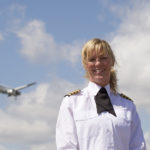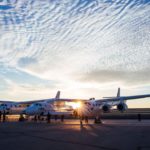There are some big changes coming to air travel in the near and more distant future – from supersonic jets, to flying cars, an exotic combination of wing, airship and helicopter, space planes and hyperloops – it’s all about getting us to our destination more quickly and easily. But which ones will fly?
The return of supersonic
Concorde was retired in 2003, but we are still drawn to the idea – and convenience – of supersonic flight. Happily, a number of companies are working on reintroducing it. The race is on.
Boom is working on its first prototype supersonic airplane. The Baby Boom XB-1 will have its first test flight in California later this year. At 160 feet long, the two-seater is a small version of the 55-passenger supersonic jet scheduled to enter service in 2023. The plan is that the bigger aircraft, with up to 200 business class-only seats, will follow for longer routes.
Boom’s jets are expected to carry passengers from Sydney to Los Angeles in 7.5 hours, instead of the best time of 13.5 hours now, and from New York to London in three hours at speeds up to Mach 2.2 – or 2,335 km per hour. Boom jets will fly at an altitude of 60,000 feet, which is high enough to see the curvature of Earth.
UK entrepreneur Richard Branson has bought options on the first ten Boom jets and Japan Airlines has options on a further 20.
In mid-2017, Aerion announced it would work with GE Aviation on an engine for its AS2 supersonic business jet. Aerion has set a target of certifying the AS2 in 2021 and placing it into service in 2023.
Then in December last year, Aerion and Lockheed Martin signed a memorandum of understanding to explore the feasibility of a joint development of the world’s first supersonic business jet, the Aerion AS2. They will work together for 12 months to develop a framework for all phases of the programme including engineering, certification and production.
Meanwhile, NASA has been concentrating on developing supersonic technology to allow flights over land – at the moment, it is forbidden in many places because of the sonic boom. It completed the preliminary design review of its Quiet Supersonic Transport (QueSST) aircraft design last summer. QueSST is the initial design stage of NASA’s planned Low Boom Flight Demonstration experimental airplane, commonly known as an X-plane.
The LBFD X-plane is now being flown over communities to collect data necessary for regulators to enable supersonic flight over land in the US and elsewhere.
Researchers in China recently unveiled plans for a hypersonic jet that can fly anywhere in the world in three hours.
A flying visit
A number of companies are working on flying cars. The theory is they will transform travel within urban areas, but not everyone is convinced about their viability.
Gartner concluded that, “High costs, safety concerns and regulatory burdens are likely to limit the use of this overhyped technology.”
On the other hand, many people thought airplanes would never take off – now there are routinely more than a million people in air at the any one time.
Undaunted, pioneers all over the world continue their work. For example, Dutch firm Pal-V recently unveiled its flying car gyrocopter at the Geneva motor show. From AeroMobil to Volocopter, the race is on to let us fly instead of taking a taxi or driving.
Airlander moves on
Airlander is described by Chris Daniels, Head of Partnerships & Communication, Hybrid Air Vehicles, as: “A mix of a wing, an airship and a bit of helicopter thrown in…An entirely new way of flying.”
The huge hybrid aircraft had a very public, hard landing in August 2016, but in July 2017, the company said it would have trials with customers underway by the end of that year.
In November, within 24 hours of a successful test flight, the aircraft broke from its mooring mast then collapsed.
At the time Airlander said: “The damage to the Airlander aircraft will result in a claim under our insurance policy of up to £32 million, being the maximum insured value.
“This incident follows a very successful flight test. Moreover, we have gained a great deal of data, information and expertise from our previous successful flight tests. We look forward to using the knowledge gained and to working with all our potential military and civil customers to develop and build production standard Airlander aircraft to meet their operational and business needs. While the damage to the aircraft will no doubt impact on our timescales and plans, our successes to date make us confident that Airlander will provide the capabilities and opportunities that will address the $45 billion market that has been independently assessed.”
This week, the company announced it was launching its next phase of development. Hybrid Air Vehicles is recruiting for nine new posts in areas such as engineering and flight sciences.
We’re hiring! A range of new roles across engineering, flight sciences and communications.
Do you want to help bring a brand new class of Aircraft to market?
Visit our careers page to view and apply – https://t.co/JVWAS2mknw#Airlander #jobs #hiring #careers #innovation pic.twitter.com/R9Bly7pUni— Hybrid Air Vehicles (@AirVehicles) March 15, 2018
Watch our video about Airlander taken at Paris Airshow in June 2017:
Stratolaunch space plane
Stratolaunch is the world’s largest aircraft by wingspan and is the largest all-composite plane ever built. The company’s aim is to “make access to space more convenient, reliable, and routine”. The aircraift is under construction at the Mojave Air & Space Port in California, and should be fully operational by the end of 2020.
Last December the company ran a successful taxiing test of a number of systems at a maximum speed of 28 miles (25 knots) an hour, including steering, braking, anti-skid and telemetry. In February, the Stratolaunch reached taxiing speeds of 46 miles per hour and continues its progress.
Hyperloop – train meets plane

A train that travels at plane speeds is what Elon Musk has in mind with hyperloop. This “fifth mode of transport” is based on ‘pods’, suspended by magnetic levitation and propelled at over 1,000 km an hour using a linear electric motor through near-vacuum tubes. The straight tubes could be underground in tunnels or above ground on columns. In theory, hyperloop could reduce a 12-hour train journey between Los Angeles and San Francisco to just 35 minutes, or replace the flight.
Dubai has agreed to conduct a feasibility study for a hyperloop link with Abu Dhabi, while Hyperloop One published the first economic study of a full scale hyperloop system between Helsinki and Stockholm. The company also recently released what it sees as the 10 strongest potential Hyperloop routes in the world.
There’s so much hyperloop activity, it’s hard to keep up. In February America’s Midwest set out plans to host the inaugural hyperloop journey. Hyperloop Transportation Technologies (HTT) formed a cross-state partnership with Illinois and Ohio to build a super-fast, cross-state shuttle, between connect the cities of Chicago and Cleveland.
Richard Branson and his Virgin Hyperloop One is also vying to be first, working with India to introduce a super-fast travel connection between Pune and Mumbai in the state of Maharashtra. At around 110 miles it’s a third of the distance of HTT’s Ohio-Illinois route. If it goes ahead, it would link Pune’s Mumbai International Airport with central Mumbai in 25 minutes – more than two and a half hours faster than the quickest train journey now.
Will hyperloop succeed?
Hugh Hunt, Reader in Engineering Dynamics and Vibration, University of Cambridge, told FINN: “The days of aircraft and ships are numbered, unless we can find a way to power them with electricity or hydrogen fuel. Hyperloop offers a novel vision of the future of long-distance travel – one that might just catch on.”

